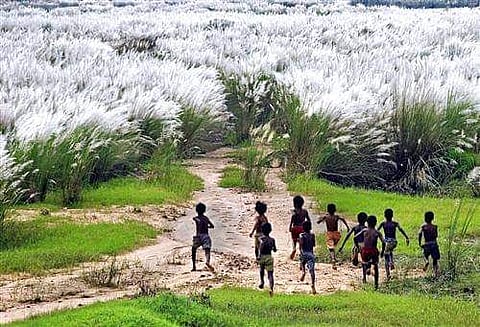
- Destinations
- Experiences
- Stay
- What's new
- Celebrating People
- Responsible Tourism
- CampaignsCampaigns
- Subscribe
- Buy Now

The dates of Durga Puja, like many Indian holidays, fluctuate year to year based on the lunar and solar calendars. The festival, which usually takes place between October and September, is also called "Sharod Utsav," with 'sharod' meaning autumn and 'utsav' meaning festival.
The blooming of the ethereal kaash flowers (wild sugarcane) heralds the arrival of fall in Bengal. These white stalks swaying against brilliant blue skies and fluffy clouds have been reliable harbingers of autumn's arrival in Bengal. And the onset of Durga Puja, Bengal's beloved festival. When you see these fleecy blossoms in full bloom, you know autumn had arrived.
Saccharum spontaneum is the scientific name for kaash phool. It blooms yearly around the same time, signalling the end of the rains and the beginning of autumn. Every year, Bengalis look forward to the kaash phool blooms. They used to grow all over Kolkata, but they are now uncommon due to the city's replacement of farms and open spaces with concrete jungles.
Kaash phool is commonly regarded as a weed. It can reach a height of 5 metres. According to scientists, it is a tenaciously invasive species known to colonise grasslands and endanger croplands. Saccharum spontaneum can also be found on river banks, the sides of roads and railways, waste ground, and the borders of ponds and lakes.
When you think of kaash phool, you immediately think of the classic sequence from Satyajit Ray's award-winning film Pather Panchali. The film depicts the child protagonist Apu and his sister Durga running across a field of kaash phool. When they hear a train whistle, the kids dash towards it through the lovely field of flowers.
Satyajit Ray described it as a "sea of fluffy whiteness" with poignancy. In the book Our Films, Their Films, Ray recounted his discovery of the field of white. “I remember the first day’s shooting of Pather Panchali very well... It was an episode in the screenplay where the two children of the story, brother and sister, stray from their village and chance upon a field of kaash flowers... At the end of the first day’s shooting we had eight shots... However, the scene was only half finished, and on the following Sunday we were back on the same location. But was it the same location?... What was on the previous occasion a sea of fluffy whiteness was now a mere expanse of uninspiring brownish grass.”
To witness the beauty of Kaash Phool, you can explore various locations across Bengal. Prime spots include the UNESCO World Heritage Site of Sundarbans, famous for its mangrove forests and diverse wildlife, where Kaash Phool graces the banks of its numerous waterways. Near Kolkata, Santragachi Jheel, a large waterbody surrounded by lush greenery, is known for abundant Kaash Phool during autumn. In the countryside of Bengal, particularly in areas like Burdwan, Howrah, and the Sundarbans, wetlands and marshes provide an ideal habitat for these enchanting grasses. Additionally, botanical gardens like the Acharya Jagadish Chandra Bose Indian Botanic Garden in Shibpur, Howrah, often cultivate designated areas for visitors to enjoy the beauty of Kaash Phool.
